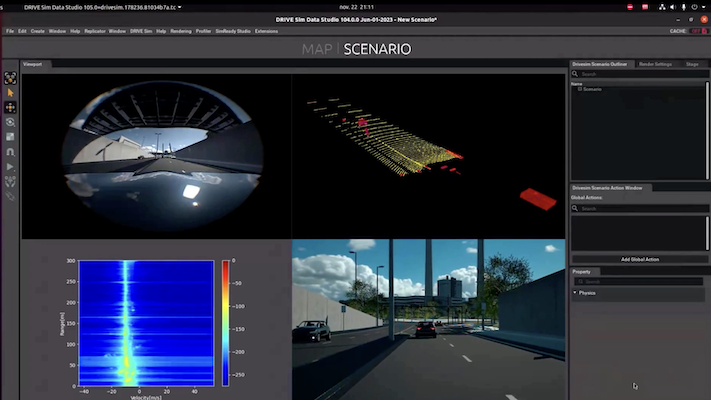|
Listen to this article  |

Ansys AVxcelerate Sensors will be able to generate simulated sensor data based on scenario-based road conditions made within NVIDIA DRIVE Sim. Credit: Ansys
Ansys AVxcelerate Sensors, the simulation giant’s autonomous vehicle (AV) sensor modeling and testing software, is now available within NVIDIA DRIVE Sim, a scenario-based simulator to develop and test automotive AI. By integrating these technologies, engineers can simulate camera, lidar, radar and thermal camera sensor data to help train and validate ADAS and AV systems.
NVIDIA DRIVE Sim is based on NVIDIA Omniverse, an industrial digitization platform based on universal scene description (OpenUSD) applications.
To meet safety standards, the AI within ADAS and AV systems must be trained and tested on millions of edge cases on billions of miles of roads. It’s not possible to do all these tests in the real world within a reasonable budget or amount of time. As a result, engineers need to use simulated environments to safely test at scale. With the latest integration of Ansys and NVIDIA technology, sensor and software performance can be tested in a digital world to meet these safety requirements.
In other words, engineers will be able to predict the performance of AV sensors, such as camera, lidar, radar and thermal camera sensors, using Ansys AVxcelerate Sensors’ simulations which will gather inputs based on digital worlds created using NVIDIA DRIVE Sim.
 Submit your nominations for innovation awards in the 2024 RBR50 awards.
Submit your nominations for innovation awards in the 2024 RBR50 awards.
“Perception is crucial for AV systems, and it requires validation through real-world data for the AI to make smart, safe decisions,” said Walt Hearn, senior vice president of worldwide sales and customer excellence at Ansys. “Combining Ansys AVxcelerate Sensors with NVIDIA DRIVE Sim, powered by Omniverse, provides a rich playground for developers to test and validate critical environmental interactions without limitations, paving the way for OEMs to accelerate AV technology development.”
In other autonomous vehicle news, Waymo recently announced it will begin testing its robotaxis on highways in Phoenix without a human safety driver. The rides will be available only to company employees, and their guests, to start. Waymo’s vehicles have been allowed on highways but required a human safety driver in the front seat to handle any issues.
Kodiak Robotics introduced at CES 2024 its sixth-generation, driverless-ready semi truck. The company said its self-driving truck is designed for scaled deployment and builds on five years of real-world testing. This testing included 5,000 loads carried over more than 2.5 million miles. The Mountain View, Calif.-based company said it will use the new truck for its own driverless operations on roadways between Dallas and Houston this year.
Credit: Source link


Comments are closed.